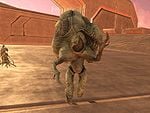Flood Carrier Form: Difference between revisions
From Halopedia, the Halo wiki
SPARTAN-118 (talk | contribs) m (Reverted edits by Ghandigotpwnd (Talk) to last version by Thunder Bomb) |
|||
| Line 64: | Line 64: | ||
==Gallery== | ==Gallery== | ||
<gallery widths="150" orientation="landscape"> | |||
File:Carrier Form Concept.png|Concept art of the Carrier Form. | File:Carrier Form Concept.png|Concept art of the Carrier Form. | ||
File:Carrier1.jpg|Carrier Form in ''Halo: Combat Evolved'' | File:Carrier1.jpg|Carrier Form in ''Halo: Combat Evolved'' | ||
Revision as of 10:21, March 8, 2011
Template:Ratings Template:Flood Species Infobox
The Carrier Form[1] is a type of normal Flood form primarily used to both create and transport Infection Forms thus effectively spreading the Flood infection.[2][3]
Overview
Carrier forms are formed from older Combat Forms[5] or from bodies that are unsuitable for combat. Lieutenant McKay theorized that Unggoy and Kig-Yar couldn't become Combat forms and instead directly converted into Carrier forms,[6] though this theory has been disproved.[7]
Combat Forms can be converted when they reach the end of their life span,[5] or become too damaged to fight. Carrier Forms perpetuate the Flood species by acting as incubators for newly created Infection Forms and keeping them safe until they're fully developed. Eventually, when a Combat Form has lived long enough, it will also evolve into a carrier, regardless of its status.
Once the Infection Forms are ready, the carrier simply explodes spontaneously, sending the new Infection Forms flying into the air. As soon as the Infection Forms are released, they begin searching for new hosts. It should be noted that Carrier Forms won't wait until full maturation has occurred.
If potential enemy hosts are nearby, it will simply get close to them and explode, sending the Infection Forms flying at the unsuspecting and often injuring or killing enemies. The explosion of a Carrier Form is similar to the explosion of a fragmentation grenade, and deals damage to anything nearby.
The Carrier form has a simple mindset, which is to release the Infection Forms it carries to a suitable host. Other than organic bodily sounds, they cannot speak or make any other sound. Though they can somehow communicate with other Carriers, possibly through a Gravemind or Brain Form, to inform them of a potential sentient being.
During the Battle of Installation 05, Carrier Forms are utilized as 'boarding parties' by the Flood. They are ejected from an airlock of an infected ship towards an uninfected ship.
Tactics
Carrier Forms are usually considered slow and of little threat unless they are close to the player. However, one particularly dangerous trait of exploding Carrier Forms is the explosive chain reactions they can cause. A Carrier explosion will cause any other Carrier Forms close enough to explode also. They also cause any nearby explosives or objects to explode. This means a single Carrier can cause a massive explosion through a chain reaction filling much of a small area. This can be used to a soldier's advantage if there are Combat or Infection Forms surrounding the Carrier(s). They are sometimes considered a "Flood grenade".
Any direct explosion eliminates the threat of the Carrier, as well as any Infection Forms that were incubating inside of it. This means that enough needles from a Needler will kill it, or you can throw a grenade at it.
Carrier Forms are one of the easiest enemies to take down. One shot from any weapon, say the Plasma Pistol, will force it to explode. However, there is not a single weapon that can actually blow it up, not even a direct Rocket Launcher. Therefore, this has to be taken into account, strategically. For example, when confronting a large number of Flood, you may wish to destroy the Carrier Forms, which in turn will kill all nearby Flood. First, allow the Combat Forms and other to get reasonably close. Then, use any weapon - preferably one which has ample ammunition - to kill it.
It is not recommended to use sniper rifles against the Flood; it is simply a waste of valuable ammo. In any case, sniper bullets simply pass through Carrier Forms, dealing virtually no damage.
In Halo: CE a good tactic is to stick one with a Plasma Grenade and shoot it with a Shotgun; this will kill the Infection Forms inside. Running over Carrier Forms, on the other hand, is a very bad idea. Their explosions will easily flip your vehicle, wasting precious time.
Trivia
- In Halo: Combat Evolved, the level "The Maw" contains a glitch in of which the Carrier Form explodes, but the Infection Forms do not move.
- They are commonly known as "blowies"
- The Carrier Form of Flood is the successor of the Simulacrums, from the Marathon (Video Game Series). The Simulacrums were cybernetic humans made to look like the crew of the U.E.S.C Marathon, the only flaw was that they all wore green jump suits, making it easy to distinguish which humans were actually Simulacrums. As soon as you were three meters close to them they would explode, heavily damaging or killing the player.
- Carrier Forms in Halo: Combat Evolved and in Halo 2 are often distinguished from their Halo 3 counterparts in the way they explode. The ones in Halo: Combat Evolved and 2 will play a death animation before exploding, and there is no way to kill them or make them explode without making them play it. In Halo 3, however, they are rigged to explode (and obviously disappear) when their health reaches zero, rather than play the death animation then explode, although they could still drop to the floor and detonate at will.
- Strangely, when shot by the Flamethrower, the Carrier Form will explode and release the Infection Forms, which seem to survive the fire. Possibly the Carrier Form's explosion puts out the fire. This is strange considering that an Incendiary grenade will kill the Carrier and the Infection Forms.
- This could be because the Incendiary grenade has a small explosive force used to scatter the flames, which would kill the infection forms.
- It is also possible that the liquid fuel in the Incendiary grenade stop the flames from being blown out by the Carrier form's explosion.
- Carrier Forms are sometimes nicknamed "popcorn", due to how they "pop" and release Infection Forms.
- Carrier Forms have a slight similarity in physical appearance to the Flood Juggernaut.
- In Halo: Combat Evolved, a Carrier form can produce short bursts of speed once it spots a target.
- In Halo 3, a Spartan Laser beam can only penetrate two Carrier Forms. In turn, this will make the Carrier Forms explode without releasing any Infection Forms at all, similar to sticking a Carrier Form with a grenade or killed by a Needler supercombine explosion.
- The Carrier Forms form in Halo: Combat Evolved and Halo 2 would release between 4-6 Infection Forms when they explode, but the Halo 3 Carrier Forms would release dozens, but this is leveled out by a smaller and less extreme damage radius.
- On rare occasions in Halo 3, the Carrier's arms and legs will be left behind upon death. However, this is exclusive to Halo 3 as the arms and legs completely vanish upon exploding in Halo: Combat Evolved and Halo 2.
- In Halo 3, Carrier Forms can jump.
Gallery
- Carrier Form Concept.png
Concept art of the Carrier Form.
- Carrier1.jpg
Carrier Form in Halo: Combat Evolved
- Flood carrier.jpg
Carrier Form in Halo 2
Sources
- ^ Halo: The Flood, page 239: The Spartan (...) sidestepped to evade a charging carrier form
- ^ Halo: Combat Evolved, level 343 Guilty Spark
- ^ Halo 2, level The Oracle
- ^ Halo 3, level Floodgate
- ^ a b Halo: First Strike, page 47: The Infection Forms rewrite a victim's cellular structure and convert him into a Combat Form, then later a Carrier Form
- ^ Halo: The Flood, page 271
- ^ Halo Wars
- ^ Halo: Ghosts of Onyx, page 197
| |||||||||||||||||||||||||||||||||

